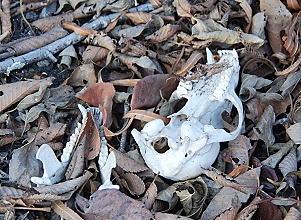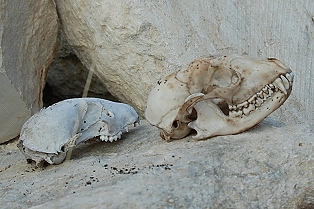In nature, things die. Plants die; animals die; rocks crumble. As a manager, it’s important for me to know what died and have some idea why. If it was a plant was it killed by disease, drought, insect damage, overuse by a native critter? Was it a juvenile, an adult, an aged adult? If it was an animal, did some other critter kill it (and if so, as it prey or a rival in a turf dispute?) or did it die of disease or old age or non-natural injury (vehicular injury, gunshot wound, poison, etc.?)
Walking in the creek woods yesterday, I found another set of bones. Both skull and lower jaw, all teeth intact, a shoulder blade, a leg bone (broken, chewed), a rib. As I had other work to do, I brought only the skull back with me, to be sure of species (I’m still learning skull shape–my guess was right, but the dental formula proved it.)
Here’s the skull as first seen, both pieces separate and upside down:

The two parts articulated perfectly, wear marks on the teeth lining up to prove (if proximity hadn’t) that these belonged to the same individual.
It’s a raccoon, as the 40 teeth and general shape prove–a mature individual (size considerably larger than some collected), also the wear marks on the canines). It does not show the blood-marks in the teeth we found in one, indicative of a possible bleeding disorder (or toxicity from a coumarin-type poison.) Raccoons around here are susceptible to distemper (as are gray foxes) but this individual might just have been old. Or it might have been taken by a larger predator.
Here’s a picture of the skull–on a rock out in the open–next to a smaller, older one that was found without the lower jaw and with fewer teeth.

Two skulls for comparison
Some of my friends refer to this as “CSI-80 Acres” …it would be, if I were more expert, but I’m not. Yet.